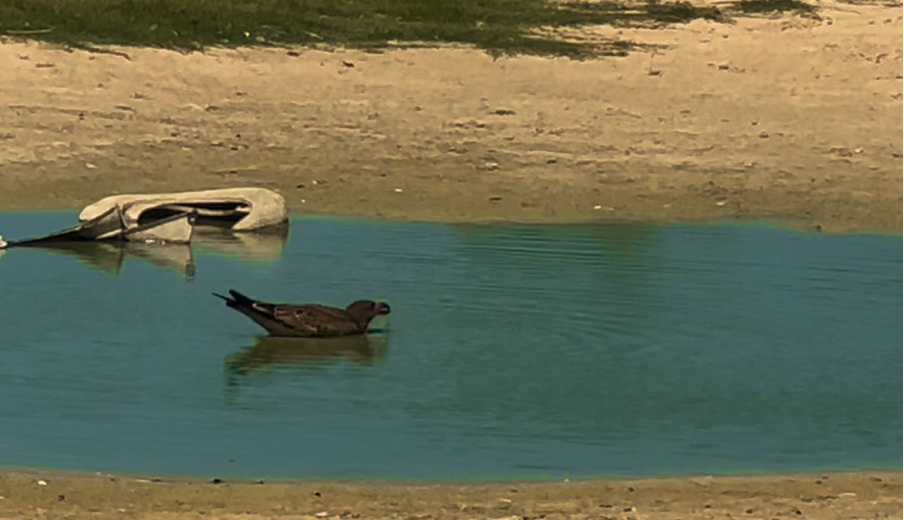A juvenile Pacific Gull drinking from a green pool at Wylie Bay. Photos: Esperance SWIRL.
ESPERANCE SWIRL CENTRE
Earlier this month we received a call from Tina and Winton of EcoValley Honey about a sick juvenile Pacific Gull they found on Wylie Beach that did not fly away when approached. Tina said: “we just couldn’t leave it there”, and they brought it to the Esperance SWIRL Centre for care. It was immediately tube fed electrolytes and kept hydrated.
A couple of hours later Dori brought an adult Pacific Gull to us from the same area. He found it sitting in mud beside a green pool, unable to fly away. Both birds were suffering from paralysis and laboured breathing.
We rang the Shire Rangers Office and Shire Ranger Selwyn and we drove to Wylie Bay to investigate. There we found a green pool of water and observed Pacific Gulls drinking from it and alerted the Shire Environmental Services group about our suspicions of Botulism poisoning.
A check of the beach revealed another deceased juvenile Pacific Gull. The Shire advised: “the Rangers have communicated with Environmental Health Officers, Wylie Bay Waste Facility Operator and Manager and the manager of Ranger and Emergency Services. The situation is being assessed and monitored and appropriate action will be taken in accordance with the Shire’s procedures.”
A check of the beach again the next morning turned up yet another deceased juvenile Pacific Gull. And there was another report of a sick adult.
Botulism, a severe and potentially fatal illness, is caused by a toxin produced by the bacteria Clostridium botulinum. While commonly associated with food poisoning in humans, it also poses a significant threat to wildlife, particularly birds like the Pacific Gull.

Understanding the Disease
Pacific Gulls, like many waterbirds, are susceptible to botulism due to their feeding habits. The bacteria thrive in decaying organic matter, such as carcasses of animals and rotting meat, which can contaminate water sources. Gulls feeding on this meat or in contaminated water can ingest the toxin, leading to paralysis and potentially death. If the disease does not kill them right away, they are also susceptible to predation by feral animals and secondary injury by domestic dogs as they cannot fly away.
Symptoms and Diagnosis
Botulism in Pacific Gulls manifests as progressive muscle weakness and paralysis. Affected birds may exhibit difficulty flying, walking, or holding their heads upright. In severe cases, they may lose the ability to swallow or breathe, leading to suffocation.
Diagnosing botulism in gulls can be challenging, as the symptoms can mimic other neurological diseases. However, a presumptive diagnosis can be made based on the bird’s clinical signs, history of exposure to contaminated environments, and the absence of other apparent causes of illness.

Care and Treatment
Unfortunately, there is no specific cure for botulism in gulls. Treatment focuses on supportive care to alleviate symptoms and prevent complications. This may include:
• Fluid therapy (usually tube fed): To combat dehydration and electrolyte imbalances.
• Nutritional support: To provide essential nutrients and energy.
• Assisted feeding: If the bird is unable to swallow or eat on its own.
• Respiratory support: In severe cases, mechanical ventilation may be necessary to assist breathing.
Prevention and Management
Preventing botulism in Pacific Gulls involves minimizing their exposure to contaminated environments. This can be achieved through:
• Carcass removal: Promptly removing dead animals from water bodies and surrounding areas to prevent the bacteria from proliferating.
• Water quality management: Maintaining healthy water quality in gull habitats by preventing pollution and ensuring adequate water flow.
• Public awareness: Educating the public about the risks of botulism and encouraging responsible disposal of animal carcasses, meat waste and organic waste.
Botulism is a serious threat to Pacific Gulls and other seabirds and waterbirds. While there is no specific cure, supportive care can help alleviate symptoms and improve the chances of survival. Ill birds need to be brought into care as soon as possible. By implementing preventive measures and raising public awareness, we can help protect these magnificent birds from this debilitating disease.
Since filing this story last week, the author reports that the green pool has been filled in.
—Ed.
Esperance Seabird and Waterbird Injury, Rehabilitation and Learning centre is a licenced wildlife rescuer




